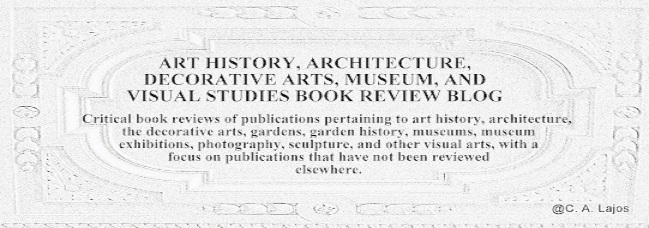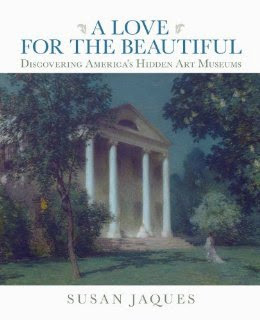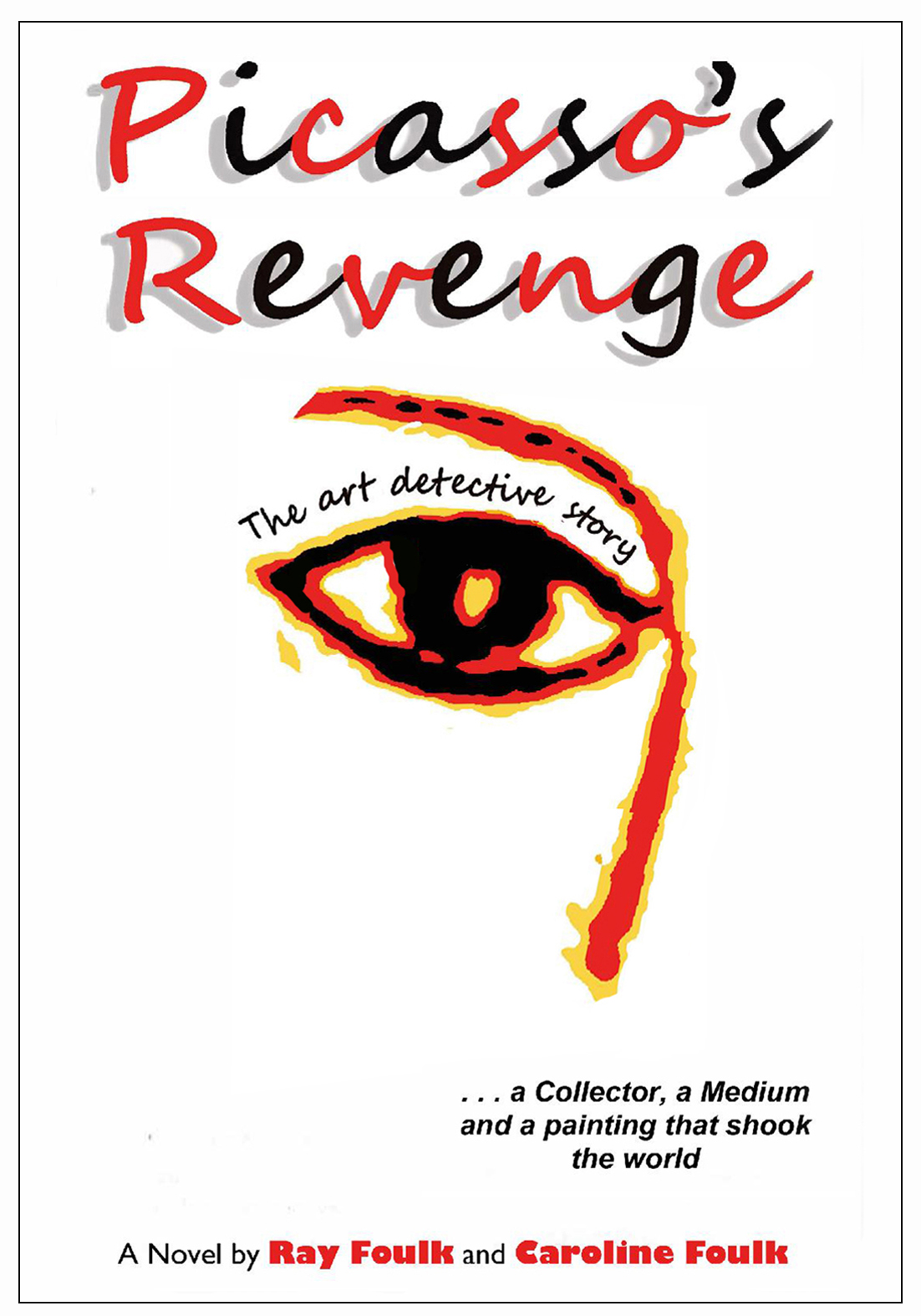Medina Publishing, February 2020. c391p. illus. ISBN 978-1911487340 $23.95.
In this ambitious debut novel, father and daughter co-authors Ray (architect, curator, and author on French Art Deco masters and twentieth century decorative arts) and Caroline Foulk (playwright and teacher) set forth “art’s greatest untold story,” the intersection of the lives of two celebrated men around one of the “most influential” but “barely known” paintings. (“Q & As,” Media Pack) In the early 1920s, French couturier and art collector Jacques Doucet (1853-1929), the founder of the renown, immensely- successful, Belle Epoque, Parisian fashion house bearing his name and a pillar of the establishment in France, acquired one of the world’s most shocking paintings, Pablo Ruiz Picasso’s (1881-1973), Les Desmoiselles d’Avignon, a representation of brothel prostitutes. Believing the work had a connection to his former lover Madame Sonia Roux, who died 14 years earlier when her husband poisoned her, the fashion designer embarked upon an obsessive quest to better understand his lover’s death, the painting, and his previous descent in the world of the Parisian surrealists and occultists. Nearly destroying his health, marriage, reputation, financial well-being, and other aspects of his life, Doucet discovered modern art’s incredible genesis and built a Temple of Arts-- his “Studio”-- in his Rue St. James home in a Parisian suburb that showcased the painting and his significant collection of western and non-western fine and decorative arts objects. On his deathbed, he put to “rest his own demons.” (“Synopsis,” Media Pack) While some readers may find this appropriately subtitled “art detective story” to be overly lengthy and difficult to follow for a number of reasons, it has a lot to recommend it. Firstly, it is based upon the lives of real and convincing characters. The authors tried to stay as faithful as possible to Picasso’s story and to all that we know about the real characters of the time, some of whom were quite obscure or unknown. (“Q & As,” Media Pack) Secondly, the themes of the book— relating to unrequited, lost love, a mysterious death, protracted grief, madness, artistic struggle, man’s struggle with God, the occult world, Belle Ėpoque Paris, developments in the fashion industry, avant-garde art, impotency, suicide, scandal, and more (“Q & As,” Media Pack)—make for compelling, fascinating reading. Based upon significant research undertaken by the authors over the course of thirty years and resumed and continued for over a decade beginning in 2005 (Holloway, Cheryl, “Guest Author Interview-Ray Foulk and Caroline Foulk”), this masterful novel by an expert father and daughter team will interest art aficionados, scholars, historical fiction buffs, fashion enthusiasts, architects, and others. It belongs in many large public and some academic and special libraries with extensive or highly focused art book collections. Strongly recommended. Advance Review Copy. Availability: Amazon.com, Barnes & Noble.com, Medina Publishing.com
Friday, November 1, 2019
Tuesday, March 21, 2017
King, Ross. Mad Enchantment: Claude Monet and the Painting of the Water Lilies.
Bloomsbury. 2016. c407p. illus. bibliog. appendix. index. ISBN 978-1-63286-012-5. $30.00. (hardback) ISBN 978-1-63286-013-2. $19.00. (paperback) ISBN 978-1-63286-014-9. $19.99. (ePub) ISBN 978-1-53666-713-4. $9.99 (audio MP3-CD). In this nicely-presented and generously-illustrated (58 black-and-white and 20 color reproductions) book, Canadian bestselling author and lecturer Ross King (Ph.D., English Literature, York University, Toronto, Canada) recounts the extraordinary story of how the French Impressionist painter Claude Monet (1840-1926) struggled during World War I to paint the series of water lily paintings that came to be known as the Grand Decoration. These paintings eventually were installed in the Orangerie Museum in Paris, France in 1927 shortly after the artist died. One of the world’s most beloved, best-known, wealthiest, and celebrated French painters during his lifetime and afterwards, Monet was an iconic figure in world culture. During the 1890s, Monet began to paint, the flowers, trees, and other objects in his garden in Giverny, France, but it was not until after the loss of his second wife Alice in 1911 and his eldest son Jean in 1914 that Monet returned to painting and began to again vigilantly paint motifs from his garden. Chronicling Monet’s paramount achievement during a period of personal loss, political upheaval, and cultural turmoil, King recounts the personal and historical dramas unfolding around the artist as he created his last, and some would say, greatest masterpiece. In addition to setting forth the details of Monet’s lavish lifestyle, tempestuous personality, and longstanding relationships with family members, friends, and others, including those pertaining to his friendship with George Clemenceau (1841-1929), France’s two-time prime minister, King also retells how Monet was affected by cataracts, self-doubts, advancing age, World War I, and more. Intimate and revealing, this well-documented and scholarly publication by an award-winning (2017 RBC Taylor Prize Winner; Los Angeles Times Book Prize finalist), bestselling author of literary nonfiction books about artists and their masterpieces significantly contributes to writings in the fields of art history and cultural history. It is very highly recommended for students, scholars, ambitious general readers, and others. It belongs in many large public, academic, and special library book collections. Review copy. Availability: Amazon.com
In this nicely-presented and generously-illustrated (58 black-and-white and 20 color reproductions) book, Canadian bestselling author and lecturer Ross King (Ph.D., English Literature, York University, Toronto, Canada) recounts the extraordinary story of how the French Impressionist painter Claude Monet (1840-1926) struggled during World War I to paint the series of water lily paintings that came to be known as the Grand Decoration. These paintings eventually were installed in the Orangerie Museum in Paris, France in 1927 shortly after the artist died. One of the world’s most beloved, best-known, wealthiest, and celebrated French painters during his lifetime and afterwards, Monet was an iconic figure in world culture. During the 1890s, Monet began to paint, the flowers, trees, and other objects in his garden in Giverny, France, but it was not until after the loss of his second wife Alice in 1911 and his eldest son Jean in 1914 that Monet returned to painting and began to again vigilantly paint motifs from his garden. Chronicling Monet’s paramount achievement during a period of personal loss, political upheaval, and cultural turmoil, King recounts the personal and historical dramas unfolding around the artist as he created his last, and some would say, greatest masterpiece. In addition to setting forth the details of Monet’s lavish lifestyle, tempestuous personality, and longstanding relationships with family members, friends, and others, including those pertaining to his friendship with George Clemenceau (1841-1929), France’s two-time prime minister, King also retells how Monet was affected by cataracts, self-doubts, advancing age, World War I, and more. Intimate and revealing, this well-documented and scholarly publication by an award-winning (2017 RBC Taylor Prize Winner; Los Angeles Times Book Prize finalist), bestselling author of literary nonfiction books about artists and their masterpieces significantly contributes to writings in the fields of art history and cultural history. It is very highly recommended for students, scholars, ambitious general readers, and others. It belongs in many large public, academic, and special library book collections. Review copy. Availability: Amazon.com , Barnes & Noble.com, Bloomsbury Publishing USA
, Barnes & Noble.com, Bloomsbury Publishing USA
Monday, December 15, 2014
Berry, David A.. The Ringling: Visitor Guide.
Scala Arts & Heritage Publishers, Ltd.. November 2014. 64p. illus. ISBN 978-1-85759-913-8. $12.95.
In this generously-illustrated (more than 90 reproductions the majority of which are in color) publication, Berry (Assistant Director of Academic and Student Affairs, The Ringling; Ph.D, University of Oxford, UK) takes readers on a very brief introductory tour of The Ringling, a unique museum complex located in Sarasota, Florida, USA. Founded in 1911 by the circus impresario and one of the richest men in America, John Ringling (1866-1936), and his wife Mable (1875-1929) when they purchased 20 acres of waterfront land in the then small town of Sarasota, upon which they built their winter residence known as the Ca’ d’Zan (i.e. “House of John” in Venetian dialect), the Ringling grew during the 20th century into one of the largest university arts complexes in the United States. (p. 6) Today it is comprised of the Ringling mansion, the Ringling art museum showcasing the couple's art collection, a circus museum, an 18th century Italian theater, an education center, gardens, and many more attractions. It purports to offer visitors a growing list of wonders to see and enjoy including historic architecture, paintings, sculpture, decorative arts objects, circus memorabilia, and gardens. Interspersed with mostly reproductions and some accessible text, this book provides an extremely succinct overview of The Ringling and its many features. Designed as a souvenir intended to enhance visitors’ onsite experiences, it can be read in less than one hour and is recommended for museum visitors. Museum aficionados, professionals, students, scholars, and others should consult other publications, if they desire more detailed and scholarly information about The Ringling, its history, collections, and many attractions. Review copy. Availability: Amazon.com, Barnes & Noble, Scala Art Publishers, Inc.
In this generously-illustrated (more than 90 reproductions the majority of which are in color) publication, Berry (Assistant Director of Academic and Student Affairs, The Ringling; Ph.D, University of Oxford, UK) takes readers on a very brief introductory tour of The Ringling, a unique museum complex located in Sarasota, Florida, USA. Founded in 1911 by the circus impresario and one of the richest men in America, John Ringling (1866-1936), and his wife Mable (1875-1929) when they purchased 20 acres of waterfront land in the then small town of Sarasota, upon which they built their winter residence known as the Ca’ d’Zan (i.e. “House of John” in Venetian dialect), the Ringling grew during the 20th century into one of the largest university arts complexes in the United States. (p. 6) Today it is comprised of the Ringling mansion, the Ringling art museum showcasing the couple's art collection, a circus museum, an 18th century Italian theater, an education center, gardens, and many more attractions. It purports to offer visitors a growing list of wonders to see and enjoy including historic architecture, paintings, sculpture, decorative arts objects, circus memorabilia, and gardens. Interspersed with mostly reproductions and some accessible text, this book provides an extremely succinct overview of The Ringling and its many features. Designed as a souvenir intended to enhance visitors’ onsite experiences, it can be read in less than one hour and is recommended for museum visitors. Museum aficionados, professionals, students, scholars, and others should consult other publications, if they desire more detailed and scholarly information about The Ringling, its history, collections, and many attractions. Review copy. Availability: Amazon.com, Barnes & Noble, Scala Art Publishers, Inc.
Saturday, September 6, 2014
Coonin, A. Victor and The Florentine Press. From Marble to Flesh. The Biography of Michelangelo's David.
B'gruppo. 2014. c272p. illus. bibliog. index. ISBN 9788897696025 (paper) $25.13. B00LB8AWD0 (kindle ebook). $17.99. 9788897696100 (Nook book). $20.99.
The gigantic marble statue of the biblical King David (c. 1501-1503) by the sculptor, painter, and architect Michelangelo Buonarroti (1475-1564) indisputably is one of the most famous statues in the world. Originally intended to stand atop one of the spurs of the Cathedral of Santa Maria del Fiore in Florence, Italy, for more than three hundred years it stood on a pedestal in Florence’s Piazza della Signoria close to the door of the town hall known as the Palazzo Vecchio, where it became a political symbol of Florence and then of Italy. Now an artistic and popular icon of nearly worldwide import, David is acclaimed as a superlative example of Renaissance art created by one of the most gifted artistic geniuses who ever lived. Inspiring millions of people over the course of its centuries- long existence, Michelangelo’s David also may be one of the most reproduced masterpieces the world has ever seen. In this publication, which was crowd funded and produced by means of the assistance of The Florentine Press, Coonin (James F. Ruffin Professor of Art History at Rhodes College, Memphis, TN; Ph.D, Art History, Rutgers University; the author of dozens of articles, essays, and catalogue entries as well as the editor of two books on Renaissance Art), a distinguished art historian who specializes in Italian Renaissance Art, writes the first ever “biography” of Michelangelo’s masterpiece, while attempting to answer the fundamental questions: What makes David so famous? Why does a 500-year-old statue of a religious figure continue to almost universally resonate with viewers? Examining his subject by means of a humanizing approach that adopts various methodologies and gives the statue and its history many lifelike qualities, the author covers the Origins, Adolescence, Maturity, Midlife Crises, and Golden Years of David. Beginning his story of the colossus long before Michelangelo secured its commission and continuing it into the 21st- century, Coonin recounts how what started simply as a monumental block of marble from a quarry in the mountains near Carrara, Italy, became in Michelangelo’s hands an embodiment of human accomplishment, perfection, magnificence, and beauty. Before and following the death of the artist in 1564, the statue endured a precarious existence on the Piazza della Signoria in Florence until it was moved to Florence’s Accademia Gallery of the Accademia delle Belle Arti during the summer of 1873, at which time it occupied what would become a specially- built space called the Tribune. During the 19th and 20th centuries, David came to be widely copied and reproduced. It appeared as and in various forms and media including casts, statutes, advertisements, body tattoos, and other commodities. Its imagery was appropriated, adapted, and/or modified by various groups, causes, and contemporary artists. Today while Michelangelo’s statue has achieved iconic status, it still remains threatened by environmental, physical, social, and other phenomena. Retelling the complete history of Michelangelo’s David up to present times, Coonin discusses all aspects of David's life and many topics, not limited to the statue’s predecessors, symbolism, and naturalism as well as the cultural, political, and social contexts in which it was viewed. He addresses many subjects about David and Michelangelo that still may be considered controversial such as their sexualities and the statue’s nudity. The author also sets forth a considerable amount of information about David’s restorations and the perils that he continues to face into the future. Scholarly yet very accessible and engaging, this noteworthy, well-presented, cleverly- conceived, first publication of its kind to consider Michelangelo’s masterpiece over the course of many centuries and in terms that humanize the statue and consider it as a living art object will be of significant interest to art lovers, students, scholars, and others. It is very highly recommended for many academic, special, and public libraries. Review copy. Availability: Amazon.com, Barnes & Noble.com, The Florentine Press
Wednesday, March 19, 2014
Minardi, Joseph. Historic Architecture in Northwest Philadelphia, 1690-1930s.
Schiffer Publishing Ltd. 2012. c272p. bibliog. illus. index. ISBN 978-0-7643-4198-4. $50.00.
, In this very profusely-illustrated publication (744 color and black-and-white reproductions), Minardi, an award-winning photographer and the author of several books on the architecture of Philadelphia (Historic Architecture in West Philadelphia, 1789-1930s; Historic Architecture in Philadelphia: East Falls, Manayunk, and Roxborough), examines the architecture of the Wissahickon Valley and the individuals who made it possible, oftentimes with the locally-sourced building stone known as Wissahickon schist. The author presents brief histories of German Township and the neighborhoods of the Wissahickon Valley, Germantown, Mount Airy, and Chestnut Hill. Covering the colonial period to the 1930s and discussing a wide variety of styles and influences, not limited to the Georgian, Colonial, Federal, Second Empire, Romantic Eclectic, and Victorian Eclectic, Minardi provides an ambitious, wide-ranging architectural history and review of 450 structures, many of which are extant and well-preserved. He features churches, inns, museums, residences, schools, and other building types while meticulously documenting his survey with captions, endnotes, a bibliography, and biographies of selected architects and their firms. Overall Minardi’s presentation of the material is thoughtful, well-organized, nicely formatted, and professional. Unfortunately, this publication lacks a good map or maps of the neighborhoods. Scholarly yet accessible, this book will be of significant interest and value to historians, architects, preservationists, residents, and some general readers who may be delighted by its superabundance of contemporary and archival images. It is very highly recommended for large public, academic, and special libraries, particularly for those located in the Delaware Valley region. Review copy. Availability: Amazon.com, Barnes & Noble.com, Schiffer Publishing
, In this very profusely-illustrated publication (744 color and black-and-white reproductions), Minardi, an award-winning photographer and the author of several books on the architecture of Philadelphia (Historic Architecture in West Philadelphia, 1789-1930s; Historic Architecture in Philadelphia: East Falls, Manayunk, and Roxborough), examines the architecture of the Wissahickon Valley and the individuals who made it possible, oftentimes with the locally-sourced building stone known as Wissahickon schist. The author presents brief histories of German Township and the neighborhoods of the Wissahickon Valley, Germantown, Mount Airy, and Chestnut Hill. Covering the colonial period to the 1930s and discussing a wide variety of styles and influences, not limited to the Georgian, Colonial, Federal, Second Empire, Romantic Eclectic, and Victorian Eclectic, Minardi provides an ambitious, wide-ranging architectural history and review of 450 structures, many of which are extant and well-preserved. He features churches, inns, museums, residences, schools, and other building types while meticulously documenting his survey with captions, endnotes, a bibliography, and biographies of selected architects and their firms. Overall Minardi’s presentation of the material is thoughtful, well-organized, nicely formatted, and professional. Unfortunately, this publication lacks a good map or maps of the neighborhoods. Scholarly yet accessible, this book will be of significant interest and value to historians, architects, preservationists, residents, and some general readers who may be delighted by its superabundance of contemporary and archival images. It is very highly recommended for large public, academic, and special libraries, particularly for those located in the Delaware Valley region. Review copy. Availability: Amazon.com, Barnes & Noble.com, Schiffer Publishing
Sunday, September 1, 2013
Jaques, Susan. A Love for the Beautiful: Discovering America’s Hidden Art Museums.
Globe Pequot Press. 2012. c288p. illus. index. ISBN 978-0-7627-7950-5. $19.95.
In this lavishly-illustrated (more than 250 full-color photographs) guide, Jaques (Bachelor of Arts, History, Stanford University; Master of Business Administration, University of California at Los Angeles), a journalist specializing in art and travel and a gallery docent at The J. Paul Getty Museum, introduces readers to art collections in fifty lesser-known American museums. Covering museums in thirty-one states with “geography” factoring into her selection process, the author showcases “diverse” museum collections that remain “hidden” or “under-the-radar” to many museum goers, even though they may be located on the “beaten path” or in “plain sight.” (p. xii) Not known for their blockbuster exhibitions or encyclopedic holdings, these “unsung,” “largely unknown” museums constitute “collecting” museums that display “extraordinary” art from their permanent collections and “tend to be exceptional in specific areas.” (pp. xii-xiii) They typically offer “unique” art-viewing experiences that are “genuine, intimate, and uncrowded.” (p. xii) Jaques organizes her book into fifteen chapters, each of which features three or four museums that have extraordinary collections in certain areas. She titles chapters: African, Pre-Columbian & Oceanic Art; American Art; Ancient Art; Asian Art; Contemporary Art; Decorative Arts, Design & Craft; European Painting, Eighteenth to Twentieth Century; Medieval, Renaissance & Baroque Art; Modern Art; Native American & Western Art; Photography; Sculpture; Single-Artists; and Spanish & Latin American Art. In each entry for a museum, Jaques describes the museum, its founder(s), buildings, collections, and history. The author also sets forth each institution’s address, contact information, website, hours of operation, and admission fee(s) as well as briefly highlights a few of its “must see” pieces. Of interest mostly to art lovers and travelers, this accessible, artfully- designed, engaging, informative, nicely- written, thoughtful, and well-presented publication by an experienced writer, traveler, and museum aficionado may be read from cover-to-cover and/or consulted by chapter and/or entry. While Jaques’s selection criteria and classification scheme may seem too arbitrary, inexplicit, personal, subjective, and/or superimposed for some readers, this book nevertheless belongs in many public, academic, and special libraries. It is recommended for individual readers as well as for library reference collections. Review copy. Availability: Amazon, Barnes & Noble.com
In this lavishly-illustrated (more than 250 full-color photographs) guide, Jaques (Bachelor of Arts, History, Stanford University; Master of Business Administration, University of California at Los Angeles), a journalist specializing in art and travel and a gallery docent at The J. Paul Getty Museum, introduces readers to art collections in fifty lesser-known American museums. Covering museums in thirty-one states with “geography” factoring into her selection process, the author showcases “diverse” museum collections that remain “hidden” or “under-the-radar” to many museum goers, even though they may be located on the “beaten path” or in “plain sight.” (p. xii) Not known for their blockbuster exhibitions or encyclopedic holdings, these “unsung,” “largely unknown” museums constitute “collecting” museums that display “extraordinary” art from their permanent collections and “tend to be exceptional in specific areas.” (pp. xii-xiii) They typically offer “unique” art-viewing experiences that are “genuine, intimate, and uncrowded.” (p. xii) Jaques organizes her book into fifteen chapters, each of which features three or four museums that have extraordinary collections in certain areas. She titles chapters: African, Pre-Columbian & Oceanic Art; American Art; Ancient Art; Asian Art; Contemporary Art; Decorative Arts, Design & Craft; European Painting, Eighteenth to Twentieth Century; Medieval, Renaissance & Baroque Art; Modern Art; Native American & Western Art; Photography; Sculpture; Single-Artists; and Spanish & Latin American Art. In each entry for a museum, Jaques describes the museum, its founder(s), buildings, collections, and history. The author also sets forth each institution’s address, contact information, website, hours of operation, and admission fee(s) as well as briefly highlights a few of its “must see” pieces. Of interest mostly to art lovers and travelers, this accessible, artfully- designed, engaging, informative, nicely- written, thoughtful, and well-presented publication by an experienced writer, traveler, and museum aficionado may be read from cover-to-cover and/or consulted by chapter and/or entry. While Jaques’s selection criteria and classification scheme may seem too arbitrary, inexplicit, personal, subjective, and/or superimposed for some readers, this book nevertheless belongs in many public, academic, and special libraries. It is recommended for individual readers as well as for library reference collections. Review copy. Availability: Amazon, Barnes & Noble.com
Monday, November 12, 2012
Stevens, Ann and Kelly, Giles. Diplomatic Gardens of Washington.
Schiffer Publishing, Ltd.. 2012. c128p. illus. bibliog. ISBN 978-0-7643-3978-3. $34.99.
In this generously-illustrated (168 color images) publication, Stevens, a widely published photographer, and Kelly, a retired US diplomat and naval officer, take readers on an exclusive, armchair traveler’s tour of twelve embassy gardens in Washington, DC. In twelve chapters, each of which showcases a different garden, they cover the best- kept embassy gardens of Washington, which are rarely open to the public. Focusing on the Ambassadors’ gardens of Australia, Britain, Denmark, the European Union, France, the Federal Republic of Germany, the Apostolic Nunciature of the Holy See, Italy, the Republic of Korea, the Royal Netherlands, Norway, and Sweden, Stevens and Kelly provide historical facts about the properties, the Ambassadors’ residences, and chanceries. They detail the unique, cultural and diplomatic histories of the gardens, their designs, features, trees, and plants. Stevens and Kelly illustrate their text by means of color photographs, many of which are full-page and further document the features, trees, and plants of the gardens. Each chapter includes many photographs, with fourteen being the average. Visually engaging, artfully designed, thoughtfully written, and intuitively presented, based upon the organization of each garden within its embassy compound, this book may interest garden lovers, horticulturalists, students, scholars, professionals, and others. Including a one- page foreword by the Executive Director of the United States Botanic Garden, Holly H. Shimizu, a table of contents, photographic captions, and bibliography, it constitutes a sufficiently well-documented addition to the literature on gardens and garden history. As a basic resource on some of the diplomatic gardens of Washington, DC, it is highly recommended for many types of libraries, not limited to large public and special libraries. Review copy. Availability: Amazon.com, Barnes & Noble.com, Schiffer Publishing Ltd.
In this generously-illustrated (168 color images) publication, Stevens, a widely published photographer, and Kelly, a retired US diplomat and naval officer, take readers on an exclusive, armchair traveler’s tour of twelve embassy gardens in Washington, DC. In twelve chapters, each of which showcases a different garden, they cover the best- kept embassy gardens of Washington, which are rarely open to the public. Focusing on the Ambassadors’ gardens of Australia, Britain, Denmark, the European Union, France, the Federal Republic of Germany, the Apostolic Nunciature of the Holy See, Italy, the Republic of Korea, the Royal Netherlands, Norway, and Sweden, Stevens and Kelly provide historical facts about the properties, the Ambassadors’ residences, and chanceries. They detail the unique, cultural and diplomatic histories of the gardens, their designs, features, trees, and plants. Stevens and Kelly illustrate their text by means of color photographs, many of which are full-page and further document the features, trees, and plants of the gardens. Each chapter includes many photographs, with fourteen being the average. Visually engaging, artfully designed, thoughtfully written, and intuitively presented, based upon the organization of each garden within its embassy compound, this book may interest garden lovers, horticulturalists, students, scholars, professionals, and others. Including a one- page foreword by the Executive Director of the United States Botanic Garden, Holly H. Shimizu, a table of contents, photographic captions, and bibliography, it constitutes a sufficiently well-documented addition to the literature on gardens and garden history. As a basic resource on some of the diplomatic gardens of Washington, DC, it is highly recommended for many types of libraries, not limited to large public and special libraries. Review copy. Availability: Amazon.com, Barnes & Noble.com, Schiffer Publishing Ltd.
Subscribe to:
Comments (Atom)















